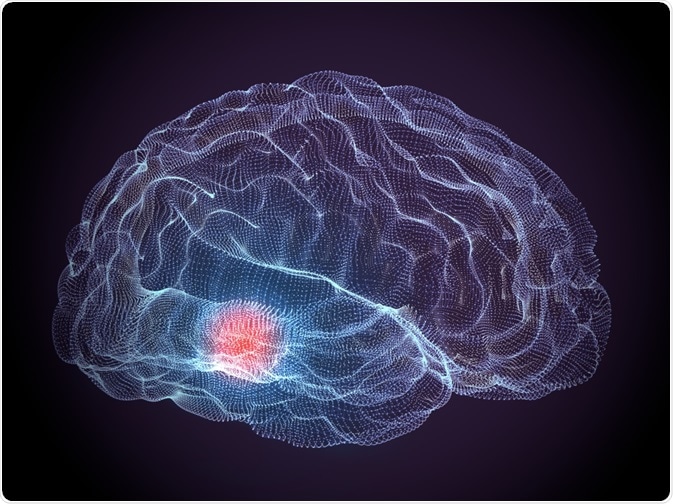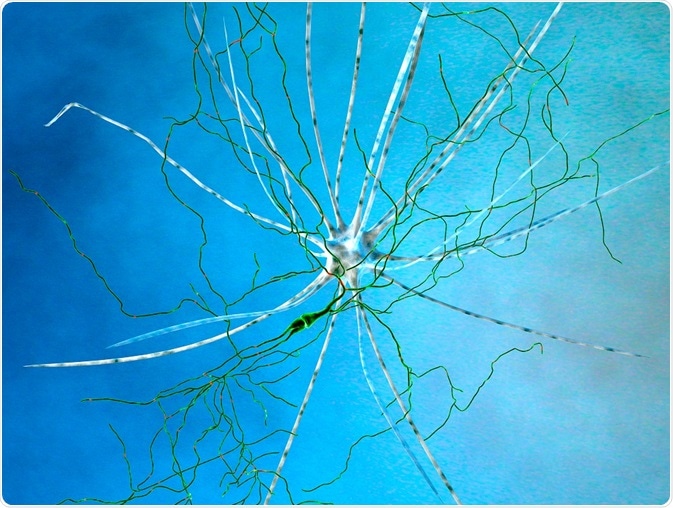Alpha-synuclein is an intrinsically disordered protein that could be important in the pathophysiology of Parkinson's disease. A group of researchers from the University of Konstanz is uncovering the dynamics of alpha-synuclein in healthy people and people with Parkinson’s disease using electron paramagnetic resonance (EPR) spectroscopy.
 Image Credit: Naeblys / Shutterstock.com
Image Credit: Naeblys / Shutterstock.com
Parkinson's disease is a devastating condition that causes loss of muscle control. Although it is well established that Parkinson's develops when there is a loss of nerve cells in the brain that produce dopamine, the exact mechanism that causes the damage to cells is not well understood and is the subject of on-going research.1
Research has found that people with Parkinson's disease accumulate Lewy bodies in their brains and other parts of their bodies. These aggregates are made up of a misfolded protein called alpha-synuclein.1
What is alpha-synuclein?
Alpha-synuclein is a protein that is abundant in the human brain. Under physiological conditions, alpha-synuclein is a soluble, intrinsically disordered protein with no tertiary structure. Scientists believe that it facilitates the release, transport, and uptake of neurotransmitters such as dopamine.1,2
When alpha-synuclein is misfolded, it becomes less soluble and forms aggregates with other proteins. Accumulation of misfolded alpha-synuclein and the formation of Lewy bodies is thought to be central to the pathophysiology of Parkinson’s disease, but their role is not entirely understood. The reason why alpha-synuclein misfolds is also unclear.1,2
Understanding how and why the conformation of alpha-synuclein changes in vivo, and its interactions with biological macromolecules is essential for understanding how Parkinson's disease develops and identifying therapeutic targets for drug development.
Scientists believe that if they could find a way to prevent alpha-synuclein from misfolding and accumulating in Lewy bodies, they may be able to slow or halt the progression of Parkinson’s disease.1,2
EPR as a tool for studying protein dynamics
Electronic paramagnetic resonance (EPR) is a popular choice for exploring the structural and dynamic properties of proteins in vivo. In EPR, unpaired electrons are detected by exposing a sample to microwave radiation in a strong magnetic field and measuring the energy absorbed, which corresponds to the energy splitting of the unpaired electron.3,4
EPR is very sensitive to the local environment, and spin-labeling using paramagnetic labels at specific amino acid positions is often used to observe the structural topology and dynamics of proteins. The technique is known as site-directed spin labeling (SDSL).4
In SDSL, when the spin-label is moving very rapidly in a flexible, disordered protein, the EPR spectrum of a protein reduces to three sharp peaks. When the spin-label is moving very slowly or still, as it would be in a highly structured protein, the peaks in the EPR spectrum change and broaden until they reach their ridged spectrum limit.4
EPR provides several advantages over other techniques; it is not destructive and can be used on functioning cells and tissues. It also provides high sensitivity compared with other technologies like nuclear magnetic resonance (NMR) and does not require expensive isotopic labels.4
Using EPR to study alpha-synuclein
The ultimate goal for scientists studying alpha-synuclein using EPR is to observe how the protein functions in living tissues and how the dynamics change in people with Parkinson’s disease.
A team of scientists from the University of Konstanz has been leading the way in studying alpha-synuclein with EPR, and they have recently published a detailed how-to for their SDSL methods, including spin labeling, sample preparation, spectroscopy, and data analysis.2
To introduce spin labels, they synthesize alpha-synuclein mutants with cysteines at desired sites, before labeling the cysteines with 3-maleimido-PROXYL. The labeled mutants are incubated with their desired interaction partners, then analyzed by Continuous- Wave-EPR using an EMXnano EPR spectrometer from Bruker Biospin. Bruker’s Xenon software is used for data processing and EasySpin 5.2.8 for data analysis.2
 Image Credit: Naeblys / Shutterstock.com
Image Credit: Naeblys / Shutterstock.com
The researchers have published several papers investigating alpha-synuclein and its interactions using their SDSL methods.
In 2014, they published an article in ChemBioChem describing how they used their technique to show that alpha-synuclein adopts a helical structure when it binds with mitochondrial membranes.5,6
Later, in 2017, the scientists reported successfully using their techniques to monitor alpha-synuclein in functioning cells. They found that both mutated versions of alpha-synuclein and wild-type versions of the protein remain intrinsically disordered in cells.5,6
Investigations into the function of alpha-synuclein in both healthy people and those affected by Parkinson's disease is still on-going. The EPR techniques developed by researchers at the University of Konstanz will undoubtedly support this effort. What's more, they can also be applied to understand the effects of conformational changes of other proteins in vivo.
References
- ‘Alpha-Synuclein in Parkinson's Disease: From Pathogenetic Dysfunction to Potential Clinical Application’ — Xu L, Pu J, Parkinson’s Disease, 2016.
- ‘Probing Alpha-Synuclein Conformations by Electron Paramagnetic Resonance (EPR) Spectroscopy’ in ‘Alpha-Synuclein: Methods and Protocols’ — Cattani J, Braun T, Drescher M, Methods in Molecular Biology, 2019.
- ‘What is EPR?’ https://www.bruker.com/products/mr/epr/what-is-epr.html
- ‘Biophysical EPR Studies Applied to Membrane Proteins’ — Sahu ID, Lorigan GA, Journal of Physical Chemistry and Biophysics, 2015.
- ‘Alpha-Synuclein Binds to the Inner Membrane of Mitochondria in an α-Helical Conformation’ — Robotta M, Gerding HR, Vogel A, Hauser K, Schildknecht S, Karreman C, Drescher M, ChemBioChem, 2014.
- ‘Room-temperature in-cell EPR spectroscopy: alpha-Synuclein disease variants remain intrinsically disordered in the cell.’ — Cattani J, Subramaniam V, Drescher M, Physical Chemistry Chemical Physics, 2019.
About Bruker BioSpin - NMR, EPR and Imaging
 Bruker BioSpin offers the world's most comprehensive range of NMR and EPR spectroscopy and preclinical research tools. Bruker BioSpin develops, manufactures and supplies technology to research establishments, commercial enterprises and multi-national corporations across countless industries and fields of expertise.
Bruker BioSpin offers the world's most comprehensive range of NMR and EPR spectroscopy and preclinical research tools. Bruker BioSpin develops, manufactures and supplies technology to research establishments, commercial enterprises and multi-national corporations across countless industries and fields of expertise.